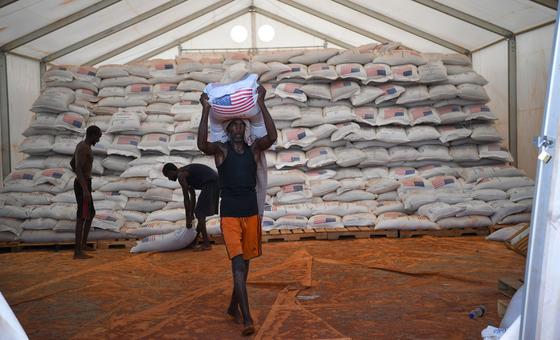The World Food Programme continues to distribute food in Ethiopia’s Somali Region (file)..
The World Food Programme (WFP) has begun rolling out food distributions to nearly 900,000 refugees in Ethiopia following a full revamp of its refugee operations.
Families living in refugee camps, including new arrivals who have fled from Sudan, are receiving food parcels for the first time since WFP paused food distributions in June, following reports of large-scale diversions.
Resuming food assistance for refugees is vital. Around 35,000 people who have fled from Sudan to Ethiopia in the last six months urgently require food assistance, while Ethiopia hosts a further 850,000 refugees mostly from Somalia, South Sudan and Eritrea.
Latest hunger data shows that refugee food security has deteriorated in the past months, leading to increased malnutrition, heightened tensions around the camps, and even unsafe journeys over borders.
‘Food is a lifeline’
“WFP teams and our partners have been working around the clock to ensure we can get food to those who need it most,” said Valerie Guarnieri, the agency’s Assistant Executive Director.
“Food is a lifeline for refugees living in unimaginably hard conditions, and it’s a relief that we now have measures in place to resume vital support.”
Distributions will resume in seven regions, providing refugees with cereals, pulses, vegetable oil, and salt. Others may receive part of their entitlement as cash assistance.
The resumption follows major reforms in camps across Ethiopia.
Twenty-four warehouses in refugee camps are now exclusively managed by WFP, while refugees will now be digitally enrolled for support through the Global Distribution Tracking Tool operated by the UN refugee agency, UNHCR.
Feedback and reporting systems for refugees also have been improved, and additional non-government organizations have been trained by WFP to manage food distributions.
Assisting the vulnerable
WFP has made progress testing and implementing measures needed to resume food distributions for millions of food insecure Ethiopians, as well.
This includes working directly with communities to identify and target the most vulnerable people and digitally register them for assistance.
It also includes enhanced logistics and distribution mechanisms that allow for more precise tracking of each family supported.

